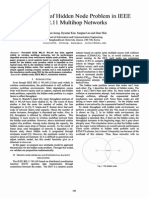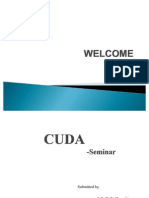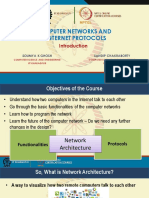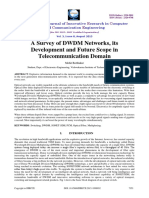Cloud Computing Presentation
Cloud Computing Presentation
Uploaded by
Muhd FauzanCopyright:
Available Formats
Cloud Computing Presentation
Cloud Computing Presentation
Uploaded by
Muhd FauzanOriginal Description:
Copyright
Available Formats
Share this document
Did you find this document useful?
Is this content inappropriate?
Copyright:
Available Formats
Cloud Computing Presentation
Cloud Computing Presentation
Uploaded by
Muhd FauzanCopyright:
Available Formats
CLOUD
COMPUTING
Which direction will
Cloud Computing take us?
Presenter :Muhd Fauzan
What is cloud computing ?
History
Services on Cloud Computing
Issue Related To Cloud Computing
Cloud Computing in Education
Conclusion
Outline
What is cloud computing ?
What is cloud computing ?
What is cloud computing ?
The "cloud" is a set of different types of hardware and software that work
collectively to deliver many aspects of computing to the end-user as an
online service.
Cloud Computing is the use of hardware and software to deliver a
service over a network (typically the Internet).
With cloud computing, users can access files and use applications from
any device that can access the Internet.
History
when John McCarthy wrote that computation may
someday be organized as a public utility. Then, grid
computing, a concept that originated in the early 1990s as
an idea for making computer power as easy to access as
an electric power grid also contributed to cloud
computing.
The general idea behind the technology dates back to the 1960s,
Source : http://www.telegraph.co.uk/news/obituaries/8851410/John-McCarthy.html
History
One of the first movers in cloud computing was Salesforce.com,
which in 1999 introduced the concept of delivering enterprise
applications via a simple website.
In 2002 Amazon started Amazon Web Services, providing
services like storage, computation and even human intelligence.
The year 2006 also saw the introduction of Amazons Elastic Compute cloud (EC2) as a commercial
web service that allowed small companies and individuals to rent computers on which to run their
own computer applications.
History
Then came Google Docs in 2006,
History
But 2009 marked a key turning point in the evolution of cloud computing, with
the arrival of browser based cloud enterprise applications, with the best known
being Google Apps Working on Google Chrome.
Needs of cloud Computing Services on Cloud Computing
What cloud computing can provide ?
Services on Cloud Computing
Software as a Service (SaaS)
Platform as a Service (PaaS)
Infrastructure as a Service (IaaS)
Allow users to run applications and store data online
Each offers a different level of user flexibility and control
Services on Cloud Computing
Software as a Service (SaaS)
Allows user to run existing online application
Example : Google Doc, Gmail, DropBox
Platform as a Service (PaaS)
Allows user to create their own cloud applications using supplier-specific tools and
language
Example : Google App Engine, Windows Azure Platform
Infrastructure as a Service (IaaS)
Allows users to run any applications they please on cloud hardware of their own
choice
Example : Amazon Web Services, GoGrid
Services on Cloud Computing
Issue Related To Cloud Computing
Security and Privacy
Reliability
Intellectual property
Security and Privacy Issue
Where services or data are stored?
Who can access your data?
How the provider protect your data?
Cybercrime on the cloud computing (Example: Hacking,
DDos, etc)
Security and Privacy Issue
Where services or data are stored?
Location of data stored based on your service cloud provider. Some customer
are aware of the danger of letting data control with an outside Cloud Computing
provider.
Who can access your data?
Cloud storage services typically allow you to set one of three settings to control
who can view your files:
private only you can view the files (although the cloud storage provider
may still be able to view your files)
public everyone can view the files without any restriction
shared only people you invite can view the files
How the provider protect your data?
Encrypt your data stored in the server
Provide secure line connection between user and cloud
Ex: using https, Secure Sockets Layer(SSL)
Used Username and Password
What attacks are most likely against cloud computing environments?
Security and Privacy Issue
Type of attack on Cloud Computing
Key Logger - a hardware device or a software program that
records the real time activity of a computer user including the
keyboard keys they press.
Denial-of-service attack (DoS) - make a machine or network
resource unavailable to its intended users
BruteForce Attack - trial and error method used by application
programs to decode encrypted data
Backdoor - access to a computer program that bypasses
security mechanisms.
Source : http://www.washingtontimes.com/news/2013/dec/5/hack-attack-2-million-
facebook-twitter-passwords/
http://www.cnet.com/news/adobe-hack-attack-affected-38-million-accounts/
Hack attack: 2 million Facebook, Twitter passwords stolen (5 December 2013)
The hackers used key logging software that was surreptitiously installed on an
unknown number of computers around the world, data analysts with the cyber security
company Trustwave found, CNN reported. The computer virus has been capturing
account sign-in information for at least a month now, and sending along that data
usernames and passwords to a server thats under the control of the hackers.
Security and Privacy Issue
Adobe hack attack affected 38 million accounts (29 October 2013)
On October 3, Adobe revealed that it had been the victim of an attack that exposed
Adobe customer IDs and encrypted passwords . At the time, the company said that
hackers gained access to encrypted credit card records and login information for
around 3 million users. But the number of affected accounts has turned out to be
much higher.
Can Cloud Computing Effectively Help Prevent Cybercrime?
Security Depends on the Type of Cloud
Security and Privacy Issue
Difficult to determine which nations laws apply to the intellectual property of a cloud
client stored or created in the cloud.
Acts constituting copyright infringement or patent infringement in one jurisdiction may
not rise to the level of infringement in another jurisdiction.
These differences in law between jurisdictions will also affect whether software and
business methods instantiated in the cloud are even eligible for patent protection.
Copyright Issue
Intellectual property
How to solve it
1) Check the storage providers terms and conditions and privacy notice
2) Ask provider about location where the data is stored.
3) What type of encryption does your cloud storage provider can offer.
Data Loss & Leakage
Human error - A employee could overwrite data or accidentally
delete it
File corruption A virus could infect and permanently destroy a
file or many files
Hardware Damage or failure of central processing unit (CPU)
Site- Damage A fire, flood, earthquake or other act of nature
could destroy the servers and render the stored data irretrievable
How to Prevent Data loss?
1. Backup your data stored in cloud
2. Always monitor your data stored.
3. Control number of user that can access to your information .
Reliability
Public and Private Cloud
Public and Private Cloud
Public and Private Cloud
PRIVATE PROS
Can be secured to meet compliance
at almost every level
Private data centers usually
accessible to IT auditors
Customizable to meet an individual
organization's needs, rather than the
mass approach of public clouds
PRIVATE CONS
More expensive to deploy and
maintain than public clouds
May have longer-term commitments
than public clouds
May have less flexibility since
hardware is dedicated to a single
organization
PUBLIC PROS
Less expensive than private clouds
More accessible than private clouds
Short-term or temporary
commitments
Faster to deploy a single user than
private clouds
PUBLIC CONS
Fewer user management controls
Security and uptime might not meet
enterprise compliance standards
Cloud Computing in Education
Easier group collaboration:
Sharing documents leads directly to better collaboration.
Many users do this as it is an important advantages of cloud computing
multiple users can collaborate easily on documents and projects
Device independence.
You are no longer tethered to a single computer or network.
Changes to computers, applications and documents follow you through the
cloud.
Move to a portable device, and your applications and documents are still
available
Improved document format compatibility.
You do not have to worry about the documents you create on your machine
being compatible with other users' applications or OS
There are potentially no format incompatibilities when everyone is sharing
documents and applications in the cloud.
Advantages
Cloud Computing in Education
Resource and Time Conscious:
With the availability of content online, it is no longer necessary for teachers to spend
time and resources printing or copying lengthy documents or lesson plans. Now,
students are able to access homework assignments, lesson notes, and other materials
online.
Cloud Computing in Education
Disadvantages of Cloud
Computing In Education
Increased internet bandwidth is
necessary to allow for use of cloud
services.
If the internet goes down, most tools
and services will be inaccessible.
Costs increase dramatically as the
number of subscribed students
increases.
Cloud Computing in Education
Globalize your workforce on the cheap. People worldwide can access the cloud,
provided they have an Internet connection.
Its a much better way to spread your resources, and it becomes easier to access
things from longer distances.
Reduce spending on technology infrastructure. Maintain easy access to your
information with minimal upfront spending. Pay as you go (weekly, quarterly or
yearly), based on demand.
Improve accessibility. You have access anytime, anywhere, making your life so much
easier!
Achieve economies of scale increase volume output or productivity with fewer
people. Your cost per unit, project or product plummets.
Conclusion
You might also like
- OSI Refrence Model TCP-IPDocument69 pagesOSI Refrence Model TCP-IPAmro Goneim100% (1)
- SOTW II and Human OdysseyDocument4 pagesSOTW II and Human OdysseyKate QaziNo ratings yet
- BC Tree BookDocument196 pagesBC Tree BookKevin Brown100% (1)
- Cloud: Get All The Support And Guidance You Need To Be A Success At Using The CLOUDFrom EverandCloud: Get All The Support And Guidance You Need To Be A Success At Using The CLOUDNo ratings yet
- REMOTE ACCESS VPN- SSL VPN: A deep dive into SSL VPN from basicFrom EverandREMOTE ACCESS VPN- SSL VPN: A deep dive into SSL VPN from basicRating: 5 out of 5 stars5/5 (1)
- FirewallDocument18 pagesFirewallkuttyNo ratings yet
- Cloud VirtualizationDocument34 pagesCloud VirtualizationJanu PrakashNo ratings yet
- ICC Lecture 03b Cloud Service Models and Deployment Models 12102022 101309amDocument57 pagesICC Lecture 03b Cloud Service Models and Deployment Models 12102022 101309amMuhammad AliNo ratings yet
- CN Unit-1 MaterialDocument21 pagesCN Unit-1 Materialabinayaa.sNo ratings yet
- Cloud ComputingDocument14 pagesCloud ComputingDuthuluru Surendra NaiduNo ratings yet
- Transport Layer: Computer Networking: A Top Down ApproachDocument66 pagesTransport Layer: Computer Networking: A Top Down ApproachMuhammad FaisalNo ratings yet
- Cloud Computing Assignment-1 (Virtualization)Document18 pagesCloud Computing Assignment-1 (Virtualization)DarshpreetKaurNo ratings yet
- Presentation On Data Communication: By-Aditya, Kopal, Nikhil, YatinDocument19 pagesPresentation On Data Communication: By-Aditya, Kopal, Nikhil, Yatinyatin rajputNo ratings yet
- 2-2 - Cloud Computing Fog Computing - v0.7Document22 pages2-2 - Cloud Computing Fog Computing - v0.7Мөнхтулга ГончигдоржNo ratings yet
- Chapter 1 - Computer Network OverviewDocument36 pagesChapter 1 - Computer Network OverviewGENENE TISENo ratings yet
- Wide-Area NetworksDocument68 pagesWide-Area NetworksGorvam SaddarNo ratings yet
- Network Function VirtualizationDocument8 pagesNetwork Function VirtualizationavaunpNo ratings yet
- ExtranetDocument13 pagesExtranetboss_84094533No ratings yet
- 6LowPAN and RPLDocument17 pages6LowPAN and RPLmadhuriNo ratings yet
- OpenStack Installation Checklist 1.1Document72 pagesOpenStack Installation Checklist 1.1srikanthreddymadhiraNo ratings yet
- Definition - What Does Computer Networking Mean?Document3 pagesDefinition - What Does Computer Networking Mean?Kenneth Jed Solomo100% (1)
- 11p What Is Cloud ComputingDocument46 pages11p What Is Cloud ComputingSai TrilokNo ratings yet
- UNIT 2 Virtualization CCDocument73 pagesUNIT 2 Virtualization CCjetowi8867No ratings yet
- Routing QuaggaDocument22 pagesRouting QuaggaDaniel AyosaNo ratings yet
- Network Automation Cookbook Pdf00002Document5 pagesNetwork Automation Cookbook Pdf00002Dang KhueNo ratings yet
- 2016 - Linux Networking Explained - 0Document27 pages2016 - Linux Networking Explained - 0Adam NyilasNo ratings yet
- LINUXDocument19 pagesLINUXtataphoton123No ratings yet
- AI PresentationDocument66 pagesAI Presentationsalemamr1010No ratings yet
- DWDM NetworkDocument3 pagesDWDM Networksin4416No ratings yet
- Iperf 3 Server Installation GuideDocument7 pagesIperf 3 Server Installation GuideHeri KiswantoNo ratings yet
- Code Division DuplexingDocument19 pagesCode Division DuplexingNitin SakpalNo ratings yet
- Cloud Computing SeminarDocument21 pagesCloud Computing SeminarEllen Jane Cantuba GuardianNo ratings yet
- Linux System Programming Part 3 - Filesystem and Files: IBA Bulgaria 2018Document17 pagesLinux System Programming Part 3 - Filesystem and Files: IBA Bulgaria 2018Калоян ТотевNo ratings yet
- Distributed Systems:: Principles and ParadigmsDocument31 pagesDistributed Systems:: Principles and ParadigmsdinkaNo ratings yet
- Vtu 5th Sem Computer Network-1 Notes 10cs55Document266 pagesVtu 5th Sem Computer Network-1 Notes 10cs55Akshata100% (1)
- 5g, Mobile NetworkDocument37 pages5g, Mobile NetworkAagam ShahNo ratings yet
- 694 Cellular NetworkDocument64 pages694 Cellular NetworkMarin AlexNo ratings yet
- Data Communication NotesDocument8 pagesData Communication NotesandreeNo ratings yet
- Cloud Computing: Presented byDocument22 pagesCloud Computing: Presented byVipul JaswalNo ratings yet
- An Analysis of Hidden Node Problem in IEEE 802.11 MultihopDocument4 pagesAn Analysis of Hidden Node Problem in IEEE 802.11 Multihopdiankusuma123No ratings yet
- Next Generation NetworkDocument3 pagesNext Generation Networkmusharaf100% (1)
- 10 Simple MacOSDocument2 pages10 Simple MacOSLord VarioNo ratings yet
- Distributed Shared MemoryDocument20 pagesDistributed Shared MemoryAsemSaleh100% (1)
- 7778 Dcap609 Cloud ComputingDocument228 pages7778 Dcap609 Cloud Computingdeveloperrahman95No ratings yet
- 5G Seminar Tour EEEboyDocument95 pages5G Seminar Tour EEEboyqwerty100% (1)
- Advance Computer NetworkDocument7 pagesAdvance Computer NetworkHIRAL AMARNATH YADAVNo ratings yet
- Networking BasicsDocument137 pagesNetworking BasicsJerald Sam ThanarajNo ratings yet
- Seminar Presentation - CUDADocument30 pagesSeminar Presentation - CUDALilly CheerothaNo ratings yet
- Cloud ComputingDocument4 pagesCloud ComputingChuru iddyNo ratings yet
- RS232 Is A Standard Protocol Used For Serial Communication)Document3 pagesRS232 Is A Standard Protocol Used For Serial Communication)Nithya Prasath100% (1)
- Day 1 (Basics)Document124 pagesDay 1 (Basics)Sahil KalaNo ratings yet
- Iperf For Bandwidth TestingDocument5 pagesIperf For Bandwidth TestingGus T.No ratings yet
- Unit 1 - Computing ParadigmsDocument31 pagesUnit 1 - Computing ParadigmsDr.Ramesh Babu PittalaNo ratings yet
- Crypt DBDocument28 pagesCrypt DBRayBoppana100% (1)
- Project ReportDocument7 pagesProject ReportRabin JoshiNo ratings yet
- Week 1 Merged PDFDocument141 pagesWeek 1 Merged PDFRaunak PatilNo ratings yet
- Wavelength-Division Multiplexing: WDM SystemsDocument7 pagesWavelength-Division Multiplexing: WDM SystemsAnand Singh ChauhanNo ratings yet
- Cloud ComputingDocument36 pagesCloud ComputingN KISHORENo ratings yet
- A Survey of DWDM Network1sDocument6 pagesA Survey of DWDM Network1sKarthic ShunmugarajNo ratings yet
- LTE Self-Organising Networks (SON): Network Management Automation for Operational EfficiencyFrom EverandLTE Self-Organising Networks (SON): Network Management Automation for Operational EfficiencySeppo HämäläinenNo ratings yet
- Economics Today The Micro 17th Edition Roger LeRoy Miller Test Bank DownloadDocument136 pagesEconomics Today The Micro 17th Edition Roger LeRoy Miller Test Bank DownloadGladys Carr100% (31)
- Balance ExerciseDocument16 pagesBalance ExerciseArkiearkie PaglumotanNo ratings yet
- (2010) The 30-15 Intermittent Fitness Test - 10 Year ReviewDocument9 pages(2010) The 30-15 Intermittent Fitness Test - 10 Year Reviewvemigix162No ratings yet
- O Fishprkk FL: A NN Exu Re - 1'Document2 pagesO Fishprkk FL: A NN Exu Re - 1'abhishekkumar00No ratings yet
- Container Can Be Defined As Isolation With Some Resource LimitsDocument8 pagesContainer Can Be Defined As Isolation With Some Resource LimitssrinivasthNo ratings yet
- (Lib24.vn) De-Thi-Vao-10-Mon-Tieng-Anh-Thpt-Chuyen-Thai-Binh-2015-2016-Co-Loi-GiaiDocument13 pages(Lib24.vn) De-Thi-Vao-10-Mon-Tieng-Anh-Thpt-Chuyen-Thai-Binh-2015-2016-Co-Loi-GiaiHồ Gia NhiNo ratings yet
- Manikanda Das ManickathDocument9 pagesManikanda Das ManickathSANDEEP KKPNo ratings yet
- AP7173Document15 pagesAP7173Rashydz BismaNo ratings yet
- Role of Nepali Army in Promotion and Preservation of Nepalese Art, Culture, and TraditionsDocument15 pagesRole of Nepali Army in Promotion and Preservation of Nepalese Art, Culture, and TraditionsAvash ShresthaNo ratings yet
- Room PoolsDocument9 pagesRoom PoolsFullbloodedscot100% (1)
- Satyanarayana Vratam Venkateswara Swamy Deeparadhana: Auspicious Time For GruhapravesamDocument2 pagesSatyanarayana Vratam Venkateswara Swamy Deeparadhana: Auspicious Time For GruhapravesamRaghu ChNo ratings yet
- Milkovich PPT Ch01Document15 pagesMilkovich PPT Ch01Jordan DriessenNo ratings yet
- CV (Resume)Document4 pagesCV (Resume)yusufahmed2329No ratings yet
- Suresh Naphade ComputationDocument2 pagesSuresh Naphade ComputationSAURABH KULKARNINo ratings yet
- Proof Methods and Strategy: Niloufar ShafieiDocument45 pagesProof Methods and Strategy: Niloufar ShafieiAnup SaravanNo ratings yet
- Salary SlipDocument1 pageSalary Sliprichard parkerNo ratings yet
- List of Head Hunters and Job Website in VietnamDocument11 pagesList of Head Hunters and Job Website in VietnamNguyen Hoa0% (1)
- Between: Baldo Sansó Rondón - And-Lexisnexis Risk Solutions Uk LimitedDocument14 pagesBetween: Baldo Sansó Rondón - And-Lexisnexis Risk Solutions Uk LimitedLukeNo ratings yet
- KENWOOD Breadmaker User ManualDocument21 pagesKENWOOD Breadmaker User ManualDaenarys TargariyenNo ratings yet
- Repertory SeminarDocument27 pagesRepertory Seminarjavvadghouri7No ratings yet
- Grade 9 Geography Homework HelpDocument8 pagesGrade 9 Geography Homework Helpg3pbvd4j100% (1)
- Resolution No. 06 - Liquor & CigarettesDocument2 pagesResolution No. 06 - Liquor & CigarettesEileen ArceoNo ratings yet
- Sampling Strategy and Sample Size For A Qualitative Research PlanDocument5 pagesSampling Strategy and Sample Size For A Qualitative Research PlanbakedcentipedeNo ratings yet
- Mini Projet 4Document55 pagesMini Projet 4Inchirah Narimane MgdNo ratings yet
- Q1/ Choose The Correct Word:: 30 Marks)Document2 pagesQ1/ Choose The Correct Word:: 30 Marks)danaNo ratings yet
- Purushartha SDocument291 pagesPurushartha SjunkyardNo ratings yet
- Basics of Enterprise Application Integration For DummiesDocument8 pagesBasics of Enterprise Application Integration For DummiesReddappa Gowd75% (4)
- Unit Number: 1 Beach Road Traffic NightmareDocument1 pageUnit Number: 1 Beach Road Traffic NightmareSami Khan Kohati100% (1)

























































































